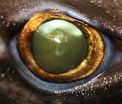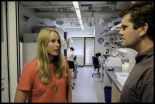(Press-News.org) Vitamin D deficiency is associated with a substantially increased risk of dementia and Alzheimer’s disease in older people, according to the most robust study of its kind ever conducted.
An international team, led by Dr David Llewellyn at the University of Exeter Medical School, found that study participants who were severely Vitamin D deficient were more than twice as likely to develop dementia and Alzheimer’s disease.
The team studied elderly Americans who took part in the Cardiovascular Health Study. They discovered that adults in the study who were moderately deficient in vitamin D had a 53 per cent increased risk of developing dementia of any kind, and the risk increased to 125 per cent in those who were severely deficient.
Similar results were recorded for Alzheimer's disease, with the moderately deficient group 69 per cent more likely to develop this type of dementia, jumping to a 122 per cent increased risk for those severely deficient.
The study was part-funded by the Alzheimer's Association, and is published in August 6 2014 online issue of Neurology, the medical journal of the American Academy of Neurology. It looked at 1,658 adults aged 65 and over, who were able to walk unaided and were free from dementia, cardiovascular disease and stroke at the start of the study. The participants were then followed for six years to investigate who went on to develop Alzheimer's disease and other forms of dementia.
Dr Llewellyn said: "We expected to find an association between low Vitamin D levels and the risk of dementia and Alzheimer's disease, but the results were surprising – we actually found that the association was twice as strong as we anticipated.
"Clinical trials are now needed to establish whether eating foods such as oily fish or taking vitamin D supplements can delay or even prevent the onset of Alzheimer's disease and dementia. We need to be cautious at this early stage and our latest results do not demonstrate that low vitamin D levels cause dementia. That said, our findings are very encouraging, and even if a small number of people could benefit, this would have enormous public health implications given the devastating and costly nature of dementia."
Research collaborators included experts from Angers University Hospital, Florida International University, Columbia University, the University of Washington, the University of Pittsburg and the University of Michigan. The study was supported by the Alzheimer's Association, the Mary Kinross Charitable Trust, the James Tudor Foundation, the Halpin Trust, the Age Related Diseases and Health Trust, the Norman Family Charitable Trust, and the National Institute for Health Research Collaboration for Leadership in Applied Research and Care South West Peninsula (NIHR PenCLAHRC).
Dementia is one of the greatest challenges of our time, with 44 million cases worldwide – a number expected to triple by 2050 as a result of rapid population ageing. A billion people worldwide are thought to have low vitamin D levels and many older adults may experience poorer health as a result.
The research is the first large study to investigate the relationship between vitamin D and dementia risk where the diagnosis was made by an expert multidisciplinary team, using a wide range of information including neuroimaging. Previous research established that people with low vitamin D levels are more likely to go on to experience cognitive problems, but this study confirms that this translates into a substantial increase in the risk of Alzheimer's disease and dementia.
Vitamin D comes from three main sources – exposure of skin to sunlight, foods such as oily fish, and supplements. Older people's skin can be less efficient at converting sunlight into Vitamin D, making them more likely to be deficient and reliant on other sources. In many countries the amount of UVB radiation in winter is too low to allow vitamin D production.
The study also found evidence that there is a threshold level of Vitamin D circulating in the bloodstream below which the risk of developing dementia and Alzheimer's disease increases. The team had previously hypothesized that this might lie in the region of 25-50 nmol/L, and their new findings confirm that vitamin D levels above 50 nmol/L are most strongly associated with good brain health.
Commenting on the study, Dr Doug Brown, Director of Research and Development at Alzheimer's Society said: "Shedding light on risk factors for dementia is one of the most important tasks facing today's health researchers. While earlier studies have suggested that a lack of the sunshine vitamin is linked to an increased risk of Alzheimer's disease, this study found that people with very low vitamin D levels were more than twice as likely to develop any kind of dementia.
"During this hottest of summers, hitting the beach for just 15 minutes of sunshine is enough to boost your vitamin D levels. However, we're not quite ready to say that sunlight or vitamin D supplements will reduce your risk of dementia. Large scale clinical trials are needed to determine whether increasing vitamin D levels in those with deficiencies can help prevent the dementia from developing."
INFORMATION: END
Link between vitamin D and dementia risk confirmed
Vitamin D deficiency is associated with a substantially increased risk of dementia and Alzheimer's disease in older people, according to the most robust study of its kind ever conducted
2014-08-06
ELSE PRESS RELEASES FROM THIS DATE:
Aggressive outreach increases organ donation among Hispanic Americans
2014-08-06
Bottom Line: An outreach campaign that included local media and culturally sensitive educational programs in targeted neighborhoods was associated with an increase in consent rates for organ donation among Hispanic Americans in the Los Angeles area.
Author: Ali Salim, M.D., of Brigham and Women's Hospital, Boston, and colleagues.
Background: Nearly 20 people die each day waiting for an organ transplant. The organ shortage affects all ethnic groups but is more pronounced in minority populations.
How the Study Was Conducted: The authors examined an aggressive outreach ...
History of fire and drought shapes the ecology of California, past and future
2014-08-06
Fire season has arrived in California with vengeance in this third year of extended drought for the state. A series of large fires east of Redding and Fresno, in Yosemite, and on the Oregon border prompted Gov. Jerry Brown to declare a state of emergency on Sunday, August 3rd.
As force of destruction and renewal, fire has a long and intimate history with the ecology of California. Ecological scientists will discuss aspects of that history in detail at the upcoming 99th Annual Meeting of the Ecological Society of America on August 10 – 15th, 2014.
"Big fires today are ...
Galápagos hawks hand down lice like family heirlooms
2014-08-06
Say what you will about the parasitic lifestyle, but in the evolution of life on Earth, it's a winner.
Given that about half of all known species are parasites, biologists have long hypothesized that the strategy of leeching off other organisms is a major driver of biodiversity. Studying populations of Galápagos hawks (Buteo galapagoensis) and feather lice that live in their plumage (Degeeriella regalis), a group led by University of Arizona ecologists and evolutionary biologists has gathered some of the first field evidence suggesting that a phenomenon called co-divergence ...
NASA's Hubble finds supernova star system linked to potential 'zombie star'
2014-08-06
Using NASA's Hubble Space Telescope, a team of astronomers has spotted a star system that could have left behind a "zombie star" after an unusually weak supernova explosion.
A supernova typically obliterates the exploding white dwarf, or dying star. On this occasion, scientists believe this faint supernova may have left behind a surviving portion of the dwarf star -- a sort of zombie star.
While examining Hubble images taken years before the stellar explosion, astronomers identified a blue companion star feeding energy to a white dwarf, a process that ignited a nuclear ...
New research links tornado strength, frequency to climate change
2014-08-06
TALLAHASSEE, Fla. — New research by a Florida State University geography professor shows that climate change may be playing a key role in the strength and frequency of tornadoes hitting the United States.
Published Wednesday in the journal Climate Dynamics, Professor James Elsner writes that though tornadoes are forming fewer days per year, they are forming at a greater density and strength than ever before. So, for example, instead of one or two forming on a given day in an area, there might be three or four occurring.
"We may be less threatened by tornadoes on a ...
Fipronil and imidacloprid reduce honeybee mitochondrial activity
2014-08-06
PENSACOLA, Fla. — New research published in Environmental Toxicology and Chemistry addresses the effects of two broad-spectrum systemic insecticides, fipornil and imidacloprid, on honeybees. These insecticides are widely used in agriculture, and the authors conclude that fipronil and imidacloprid are inhibitors of mitochondrial bioenergetics, resulting in depleted cell energy. This action can explain the toxicity of these compounds for honeybees.
Scientists are urgently trying to determine the causes of colony collapse disorder and the alarming population declines of ...
Community religious beliefs influence whether wives work outside home, Baylor study finds
2014-08-06
Married women who live in communities in which a higher proportion of the population belongs to conservative religious traditions — such as evangelical or Mormon — are more likely to choose not to work outside the home, even if the women are not members of those faith groups, according to a Baylor University study.
The study — "Work-Family Conflict: The Effects of Religious Context on Married Women's Participation in the Labor Force" — appears in the journal Religions in a special issue, "Religion, Spirituality, and Family Life."
While previous research has shown individual ...
Photon hunting in the twilight zone
2014-08-06
The eyes of deep-sea bioluminescent sharks have a higher rod density when compared to non-bioluminescent sharks, according to a study published August 6, 2014 in the open-access journal PLOS ONE by Julien M. Claes, postdoctoral researcher from the FNRS at Université catholique de Louvain (Belgium), and colleagues. This adaptation is one of many these sharks use to produce and perceive bioluminescent light in order to communicate, find prey, and camouflage themselves against predators.
The mesopelagic twilight zone, or about 200-1000 meters deep in the sea, is a vast, ...
Young loggerhead turtles not going with the flow
2014-08-06
Juvenile loggerhead turtles swim into oncoming ocean currents, instead of passively drifting with them, according to a study published August 6, 2014 in the open-access journal PLOS ONE by Donald Kobayashi from National Oceanic and Atmospheric Administration and colleagues.
After loggerhead turtle hatchlings leave nesting beaches, they live in the ocean for 7-12 years before migrating to coastal habitats. Juvenile loggerhead turtles have good swimming abilities, but scientists aren't sure if they passively drift in ocean currents or actively swim. Combining turtle movement ...
HSCI researchers identify another potential ALS treatment avenue
2014-08-06
Cambridge, MA, Aug 6 - A series of studies begun by Harvard Stem Cell Institute (HSCI) scientists eight years ago has lead to a report published today that may be a major step forward in the quest to develop real treatments for amyotrophic lateral sclerosis, ALS, or Lou Gehrig's disease.
The findings by Harvard professor of Stem Cell and Regenerative Biology (HSCRB) Kevin Eggan and colleagues also has produced functionally identical results in human motor neurons in a laboratory dish and in a mouse model of the disease, demonstrating that the modeling of human disease ...
LAST 30 PRESS RELEASES:
New software sheds light on cancer’s hidden genetic networks
UT Health San Antonio awarded $3 million in CPRIT grants to bolster cancer research and prevention efforts in South Texas
Third symposium spotlights global challenge of new contaminants in China’s fight against pollution
From straw to soil harmony: International team reveals how biochar supercharges carbon-smart farming
Myeloma: How AI is redrawing the map of cancer care
Manhattan E. Charurat, Ph.D., MHS invested as the Homer and Martha Gudelsky Distinguished Professor in Medicine at the University of Maryland School of Medicine
Insilico Medicine’s Pharma.AI Q4 Winter Launch Recap: Revolutionizing drug discovery with cutting-edge AI innovations, accelerating the path to pharmaceutical superintelligence
Nanoplastics have diet-dependent impacts on digestive system health
Brain neuron death occurs throughout life and increases with age, a natural human protein drug may halt neuron death in Alzheimer’s disease
SPIE and CLP announce the recipients of the 2025 Advanced Photonics Young Innovator Award
Lessons from the Caldor Fire’s Christmas Valley ‘Miracle’
Ant societies rose by trading individual protection for collective power
Research reveals how ancient viral DNA shapes early embryonic development
A molecular gatekeeper that controls protein synthesis
New ‘cloaking device’ concept to shield sensitive tech from magnetic fields
Researchers show impact of mountain building and climate change on alpine biodiversity
Study models the transition from Neanderthals to modern humans in Europe
University of Phoenix College of Doctoral Studies releases white paper on AI-driven skilling to reduce burnout and restore worker autonomy
AIs fail at the game of visual “telephone”
The levers for a sustainable food system
Potential changes in US homelessness by ending federal support for housing first programs
Vulnerability of large language models to prompt injection when providing medical advice
Researchers develop new system for high-energy-density, long-life, multi-electron transfer bromine-based flow batteries
Ending federal support for housing first programs could increase U.S. homelessness by 5% in one year, new JAMA study finds
New research uncovers molecular ‘safety switch’ shielding cancers from immune attack
Bacteria resisting viral infection can still sink carbon to ocean floor
Younger biological age may increase depression risk in older women during COVID-19
Bharat Innovates 2026 National Basecamp Showcases India’s Most Promising Deep-Tech Ventures
Here’s what determines whether your income level rises or falls
SCIE indexation achievement: Celebrate with Space: Science & Technology
[Press-News.org] Link between vitamin D and dementia risk confirmedVitamin D deficiency is associated with a substantially increased risk of dementia and Alzheimer's disease in older people, according to the most robust study of its kind ever conducted




